Herbs – the spice of life
When late afternoon arrives in our patch of yard, we turn on the reading lights. That’s because we live in dappled shade and shadows from our forested northeastern exposure. 1/2 block away it’s full sun, while we’re calling it a day.
One outcome of our scant daylight is we don’t grow food, or anything else that requires full sun. Which is OK by me because my short stint as a food grower was neither a personal or agricultural success.
Consumers are people, too
I support the concept of growing your own nutrition, but I do not support the worry: fungus, beetles, blight, cut worms, watering, fertilizing, weeding, thinning, fencing and harvesting gallons of one thing (I hope you like squash, dear). And then, it starts again next year. From scratch.
Do I lack intestinal fortitude? No, I just can’t tolerate the suspense of bringing in a crop. I gladly shop for local produce. Just leave me to my perennials.
Best of both worlds
I designed my garden for other senses – mind, eye, nose
– outdoor spaces, fragrant offerings, inspiring creations, intriguing curves, mini-vistas and low maintenance. OK, I pamper the roses a bit. Everything else weathers; a planting survives and thrives or … succumbs. Perennial pragmatism.My one exception: herbs and annuals in pots. I hate buying fresh mint at the supermarket. Ditto parsley, sage rosemary and thyme, invariably expensive or trucked from Mexico. In pots, these herbs unfailingly just grow, and without fuss — my kind of crop! They satisfy my gardening principles while providing a culinary and aesthetic je ne sais quoi.
Besides the flavor-your-food value of herbs, groupings of pots in different shapes and sizes partition and highlight an area, add graceful greenery / vivid accents, and blend practical herbs with vibrant annuals (my fave – nasturtium with lobelia). Pots of varying sizes, habitats and materials punctuate my external rooms.
I have a few herbal and non-herbal relics that winter over — bits of this and that: liatris spicata, lamium “White Nancy”, dicentra, ferns. Even my potted oregano returns each year and mint, running freely in the perennial beds, is rampant. While they do not survive Zone 6A winter, I’ve harvested parsley in late December and rosemary in January. First frost does in the basil – it’s known as a tender perennial.
Terracotta and Not
I use both clay pots and plastic pots. Classic terracotta (literally baked earth, unglazed clay) is porous, warm and weathered. Saucers under the clay pots extend the watering effect. Plastic scores lower for aesthetics but meets the low maintenance requirement because it conserves moisture much better than terracotta. That means less stress on the plants and less work for me.
I’ve taken to the heavily glazed, gigantic earthenware pots from Vietnam. They conserve water, do not crack like terracotta and make a bold statement that anchors a grouping of smaller pots. Filled with soil, they stay put!
Global watering
For pots that need chronic watering, I discovered a remedy that works pretty well — the glass watering globes that you fill with water and stick into the potted soil.
In the past I had tried mixing in the gelatinous granules (polymers) that soak up water and then release it to the plants. It’s a clever idea that doesn’t work well. Mostly the granules expand beyond reason, force the soil out of the pot, and don’t deliver much water to the roots of your potted plants. My experience is supported by research.Food for Thought
While my aesthetic vision continues to conjure up garden designs, I find joy in snipping fresh rosemary, basil, and perennial mint into my cuisine, or pinching a spicy nasturtium flower to decorate dinner. It’s another way I delight my soul.

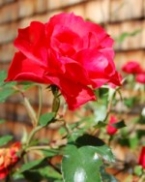
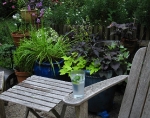 pots-with-chair
pots-with-chair potted-herbs-annuals
potted-herbs-annuals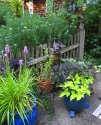 pots-with-chair2
pots-with-chair2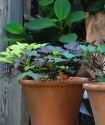 pots-sweetpotato
pots-sweetpotato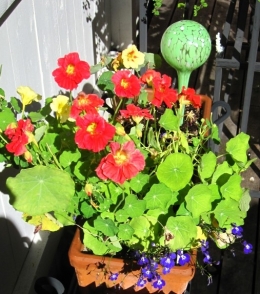
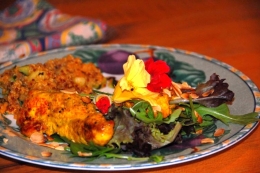

loved reading about herbs and the photos are delightful! I took this opportunity to read some of your “back issues”… wonderful chatty column, I am impressed!! love sister meg
Yummy!
I’m not sure why, but I cannot seem to get herbs to grow from seed on my porch…perhaps its the limited sunlight, but I’m happy to hear that once started, they are fairly easy. I think I’ll give them another try :)
Starting herbs from seed is another kettle of fish entirely. Start with small, potted herbs from another grower, first.
If you can grow herbs in a flowerpot, you can grow lettuce in a windowbox. Just add a little dolomite and fertilizer to some potting mix, strew some salad mix seeds, and you will have all you can handle. I am currently eating salad from the thinnings every night. Another extremely undemanding green is mache (pronounced “mosh”). Somewhat slow-growing, but hardy and extremely cold-tolerant. Makes a nice sweet salad herb. Interesting look, too – little green rosettes. I want to try some Claytonia, too – another non-traditional salad herb.
I grow mini-bok-choi (Joi Choi) in window boxes, too.
Describe your windowbox – where does it sit, fit, light, cold protection, etc. etc.
I have a little plastic tent – I think it is called a “flowerhouse” that I have used for years. I have a small ceramic heater with a thermostatic switch that I keep set at about 35 degrees just to keep it from freezing. Inside, I have large windowboxes and a few “Earth Boxes” that are doing salad duty now, but will be moved outside and planted with summer crops in April. At the same time I will plant more windowboxes – out of the tent, on a south-facing concrete stoop. I grew lettuce mixes from seed, and planted buttercrunch heads as seedlings. We have more fresh lettuce than we know what to do with, and at this time of year – no pests!
Oh these pictures have me so excited for the warm weather. Nothing beats summer at 153
I saw firsthand who was making money and who wasn’t, what worked and what didn’t,
what people wanted that wasn’t available and what was
to easy to find but wasn’t wanted. Perhaps you
want to do landscaping on the side and go full-time when you
already have a steady list of clients. This is particularly
useful if your backyard is not fenced in.